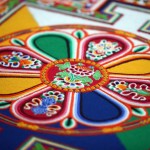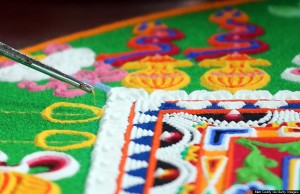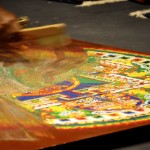 Hat tip and thanks to Huffington Post’s Antonia Blumberg for today’s gorgeously illustrated exploration of the ephemeral art of Tibetan Buddhist sand paintings, or mandalas.
Hat tip and thanks to Huffington Post’s Antonia Blumberg for today’s gorgeously illustrated exploration of the ephemeral art of Tibetan Buddhist sand paintings, or mandalas.
In both Buddhist and Hindu traditions, the term mandala is layered with meaning. It can refer to both a symbol, and a reality. It can be a focus for creating the sacred, and it can be a factual statement of the very much mundane.
In the most familiar, and possibly the most moving respect, a mandala is a two-dimensional, mathematically precise representation of the Buddhist universe, containing ideations of spheres of existence, of convergences of energies, and of wisdom itself.
containing ideations of spheres of existence, of convergences of energies, and of wisdom itself.
And since mandalas convey the graphical equivalents of Buddhist thought, it’s important, maybe vital, that they embrace the most important aspects of that  philosophy. One such aspect is impermanence: These examples are built of that most shifting of substances, sand.
philosophy. One such aspect is impermanence: These examples are built of that most shifting of substances, sand.
Another central Buddhist theme: non-attachment. It’s almost inconceivable, especially for an artist or indeed for anyone who might spend hundreds or thousands of hours on a creative endeavor—but an integral phase of mandala construction is its inevitable and looming destruction.
mandala construction is its inevitable and looming destruction.
If you ever get a chance to see the creation of a mandala, by all means take it. You’ll be blown away by the detail, by the meticulous craftsmanship, and hopefully by the thought and intent. You needn’t be Buddhist, and you need not sit and meditate on the dharma. But, understanding that the artwork before you will be born, exist, and die in the course of a matter of days, you’ll experience transience writ in the microcosm—something that can and should be compatible with all strains of faith, or none.
It’s been quite a few years since I stood, transfixed, and watched three monks build their fleeting pattern of the Wheel of Time. Days later it was reduced to its constituent parts, and was gently released into the river.
Parts of it, and maybe its whole, must surely still be there. I know they’re here with me.